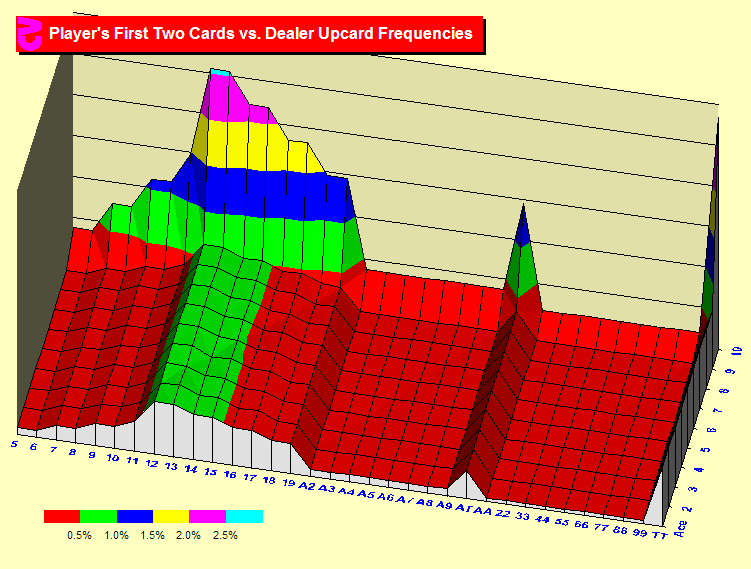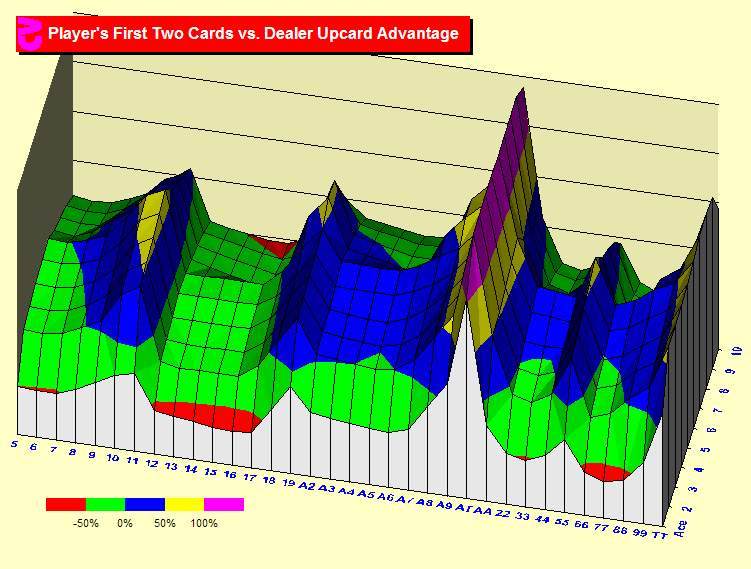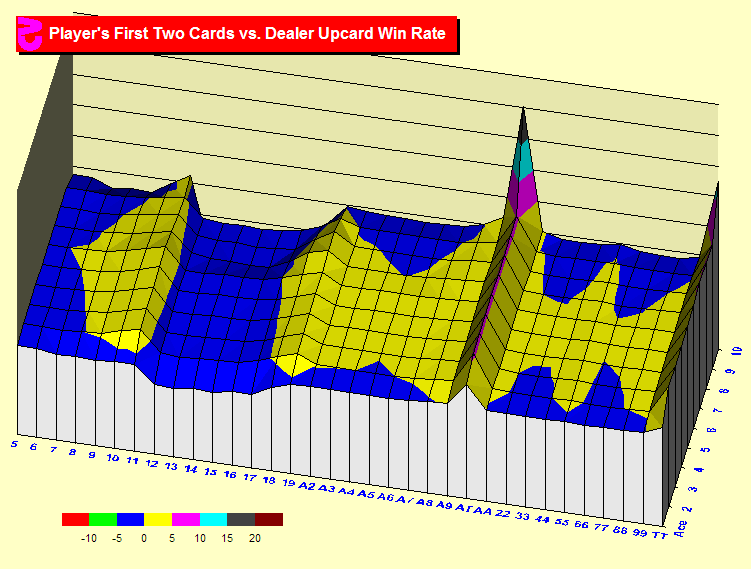|
|
First Two Cards & Dealer Upcard Frequencies
 What
Blackjack hands do we get? What
Blackjack hands do we get?
On the previous pages we looked at the 34 possible initial hands
that the player can get. But the dealer upcard is nearly as important.
Here we will look a bit deeper by including the dealer upcard. As
there are ten possible upcards, there are 340 possible initial two-card
hands and dealer upcard. These charts are more complex and require
three dimensions. As in the previous charts, the x-axis shows each
of the 34 initial two card hands. The third dimension (depth) shows
the ten possible dealer upcards. The peaks show the highest frequency
hands. The first chart on this page is the simplest three-d chart.
The most common hand is T,T vs. T. This is the very sharp peak at
the far right-rear. The next most common hands are player 12 and
13. The hands with a dealer upcard of Ten are about four times as
likely as the hands with upcards of ace–nine because there
are four ties as many Tens in the shoe. However, they are not exactly
four times as common since a dealer upcard of Ten means there is
slightly less likelihood of your hand having a Ten. The legend at
the lower left defines the colors. Red indicates that a hand occurs
less than 0.5% of the time. Green indicates 0.5% to 1%, etc.
|
 What
are the good Blackjack hands? What
are the good Blackjack hands?
Now it gets more complicated. Here we see the same 340 hands. But
instead of the frequency of each hand, we see the advantage of each
hand. That is, average gain or loss if you get the hand. Green and
Red have a negative advantage. Blue, Yellow and Purple have increasing
degrees of positive advantage. Obviously Blackjack is the best hand.
You can see a gain of 150% except against an Ace or Ten where there
is a bit of a downward slope. As you would expect, stiffs (12-16)
are the worst hands and 17 is nearly as bad. But this chart also
shows that the upcard is very important. You can see red areas on
either side of the chart where the advantage falls below -50%. These
are hands against a dealer Ten or Ace. And you will see a ridge
down the center of the chart where the dealer upcard is a six. A
dealer six is particularly good with player pairs. It is no surprise
that 16 against Ten and Ace are the lowest valleys in the chart.
|
 What
Blackjack hands get the money? What
Blackjack hands get the money?
First we looked at how often we get each hand. Then at the advantage
of each hand. Now we look at the overall win rate or gain from each
hand. What's the difference between advantage and win rate? Well
a hand may have a high advantage when we get it. But if we don't
get it very often, its overall value is less. Win rate is advantage
times frequency and tells us the overall money won or lost for each
possible hand. This chart looks quite a bit different. Here blue
indicates a loss and the other colors indicate increasing wins.
Blackjacks are still the most valuable hands. Blackjack against
a Ten is the largest gainer. It's a scary hand since the dealer
may also have a BJ. But, it is more common and therefore results
in a higher total gain. Pairs and soft hands now show a very small
gain or loss due to their low frequency. Ten, Ten is very important
not only because it is a good hand but because it occurs so frequently.
The Advantage chart showed 16 to be the worst hand. Not surprising
as you will probably lose when you get it. But this chart shows
13 and 15 as the worst hands because you will still probably lose
them, but they occur a bit more often. As in the previous chart,
the gain against a dealer Ten or Ace is lower and in some cases
there is a loss against these cards where a gain existed against
other dealer upcards.
|
|
Sim details
- Six decks, S17, DAS, LS, Heads-Up, Basic Strategy, 75% Penetration
- Ten billion rounds each
|
|
|
 What
Blackjack hands do we get?
What
Blackjack hands do we get? What
are the good Blackjack hands?
What
are the good Blackjack hands? What
Blackjack hands get the money?
What
Blackjack hands get the money?